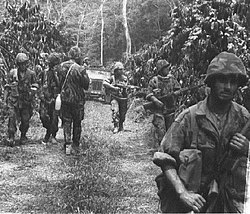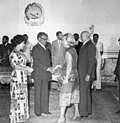Angolan Civil War
The Angolan Civil War was a major civil war in the African country of Angola. It started in 1975 and continued until 2002. The war began right after Angola became independent from Portugal in November 1975. The Civil War was mostly a fight for power between two former liberation movements, the People's Movement for the Liberation of Angola (MPLA) and the National Union for the Total Independence of Angola (UNITA). Other countries got involved in the war because they wanted their own ideologies to win. This made the Angolan war part of the Cold War. In 2002 the MPLA won.
| Angolan Civil War | |||||||
|---|---|---|---|---|---|---|---|
| Part of the Cold War and the South African Border War | |||||||
 Cuban and Angolan officers consulting a military operation. | |||||||
| |||||||
| Belligerents | |||||||
|
Supported by: |
Supported by: | ||||||
| Commanders and leaders | |||||||
|
|
| ||||||
| Strength | |||||||
|
| ||||||
| Casualties and losses | |||||||
|
|
| ||||||
| Over 500,000 civilians killed[11] | |||||||
About 500,000 people died in the war. The war also did a lot of damage to buildings in Angola. Because of all the damage, in 2003 80% of Angolans lacked access to basic medical care, 60% lacked access to water, and 30% of Angolan children would die before the age of 5, with an overall national life expectancy of less than 40 years of age. With the civil war between 1975 and 2002 it was 27 years of fighting.[12]
Background
In 1575, the Portuguese started to colonize parts of what is now Angola. Before, some of the land was part of the Kingdom of Kongo.
Combatants
MPLA
The MPLA was a communist group fighting for Angolan independence. Its leader was Agostinho Neto. They were supported by the Soviet Union.
UNITA
UNITA was an anti-communist group also fighting for Angolan independence. Its leader was Jonas Savimbi.
FNLA
FNLA was another anti-communist independence group. Its leader was Holden Roberto. The US gave them money by funneling it through Zaire.
War
1970s
In 1975, Portugal signed the Alvor Agreement with MPLA, UNITA, and FNLA. The agreement said, that, Angola would become independent on 11 November 1975.
Aftermath
The war destroyed a lot of buildings in Angola. There are still landmines remaining killing and hurting people.
Angolan Civil War Media
Portuguese colonies in Africa at the time of the Portuguese Colonial War (1961–1974)
Portuguese Army soldiers operating in the Angolan jungle in the early 1960s
Senator Dick Clark
Agostinho Neto, MPLA leader and Angola's first president, meets with Poland's ambassador in Luanda, 1978
References
- ↑ "AfricanCrisis". Archived from the original on 2012-03-13. Retrieved 2012-04-24.
- ↑ La Guerras Secretas de Fidel Castro Archived 2012-01-18 at the Wayback Machine (in Spanish)
- ↑ Africa South of Sahara 2004, page 66
- ↑ 4.0 4.1 "Web Page Under Construction". www.cubamatinal.com. Archived from the original on 2012-01-18. Retrieved 2012-04-24.
- ↑ "CHAPTER XI: Chevron-Gulf Keeps Marxist Angola Afloat". Archived from the original on 2012-03-15. Retrieved 2012-04-24.
- ↑ "struggle,_civil_war,_and_intervention.html Angola-Independence Struggle, Civil War, and Intervention".[dead link]
- ↑ Political terrorism: a new guide to actors, concepts, data bases, theories and literature
- ↑ "Fidel Castro of Africa! - Natna". Archived from the original on 2013-08-06. Retrieved 2012-04-24.
- ↑ Shubin, Gennadiĭ Vladimirovich; Tokarev, Andreĭ Aleksandrovich (14 February 2019). Bush War: The Road to Cuito Cuanavale: Soviet Soldiers's Accounts of the Angolan War. Jacana Media. ISBN 978-1-4314-0185-7 – via Google Books.
- ↑ Sudakov, Dmitry (15 February 2011). "Soviet Union and Russia lost 25,000 military men in foreign countries". PravdaReport. Archived from the original on 20 February 2019. Retrieved 14 February 2019.
- ↑ Madsen, Wayne (2002-05-17). "Report Alleges US Role in Angola Arms-for-Oil Scandal". CorpWatch. Archived from the original on 2008-01-05. Retrieved 2008-02-10.
- ↑ Polgreen, Lydia (2003-07-30). "Angolans Come Home to 'Negative Peace'". The New York Times. Retrieved 2008-02-10.








